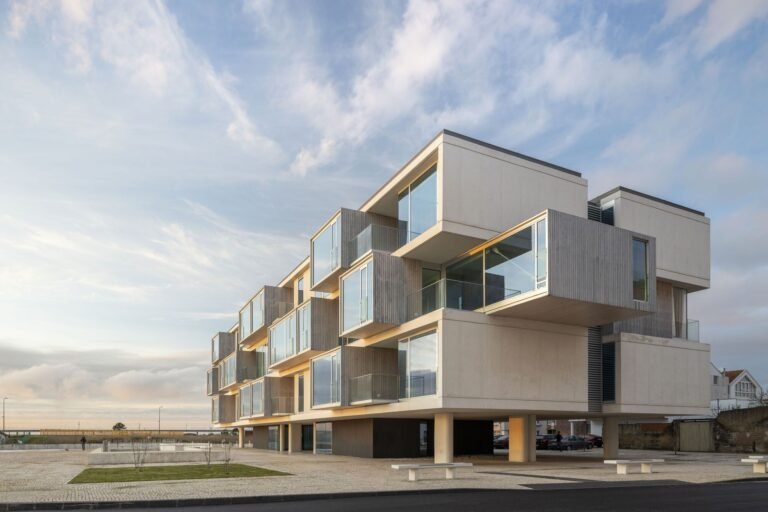Dallas’s new Virgin Lodge creates a diamond-esque view within the Design District
A new Virgin Hotel has risen above Dallas’ growing Design District, with a diamond-patterned aluminum facade that envelopes 268 rooms and over 15,000 square feet of indoor and outdoor event space. Designed by the Dallas-based 5G Studio Collaborative, the hotel is only a block away from the Trinity River, whose future includes a major parks and recreation project that will complement the Design District’s growth.
Programmatically, the building also hosts a ballroom, conference spaces, a rooftop pool deck, and a parking garage. Positioned on a corner lot, the facade’s angularity was broken by a curved front corner of the hotel, which featured wider windows under a large ‘Virgin Hotels Design District’ sign. This corner was rounded in order to accommodate existing pedestrian walkways, and along with the larger openings of the building, contrasts with the diamond pattern and right angles that lend the rest of the facade its shape. The lower levels of the facade are airier, while the upper levels contain a standard array of windows that would be expected from a hotel. Exterior spaces open to guests cut into the level that serves as a border between the two sections, delineating the public lower levels and more private guest rooms.

The lowest levels of the building were designed to be more open, with the diamond shape of the facade filtering sunlight and wind to maintain a connection to nature for those passing through. As 5G partner Yen Ong explained, “the rhombus geometry was selected for its association to the representation of diamonds and beauty.” Variations in the pattern were an exploration of light emissivity, meant to invoke the sparkling effect of cut diamonds.

The specific geometries of the facade’s aluminum panels also took into account technical details, based on both programmatic needs and environmental conditions. On the lower floors, most of the diamond shapes were hollow, whereas across the upper levels where most of the hotel rooms are, solid panels provided more privacy. The solid panels were raised along diagonals, with “the three-dimensionality resulting in different qualities of light shading to fall on their faces throughout the day,” creating a more dynamic curtain wall. This again contrasts with the lower levels, where Ong says that variations in perforations aimed to simulate the experience of being under a tree canopy. On the garage level, perforations allow for cross ventilation while blocking the visibility of car lights from the exterior.

The design process included extensive simulation of the perforations and angles of the panels in order to properly account for and understand the impacts of environmental factors. Sunlight, heat gain, and wind were considered not in order to be completely shielded from occupants but to allow for a comfortable experience. Glazing with a low U-value was used to ensure high-performance and low interior reflectance, paired with high visible light transmittance guaranteed the privacy of guests while not entirely shielding them from exterior views.

The design process was also a very collaborative effort with Cleburne Sheet Metal, who both manufactured and installed the aluminum panels. Through a “series of mock-ups… perforation tests, and the proposed attachment methods,” the team was able to understand the varying visual impacts of different fabrication methods on the design of the facade. Fabrication challenges included the points where both the front and back of the panels were visible, forcing not only a high degree of precision in construction but the concealment of the substructure within the panels so as not to be seen by the public.
The curved front and diamond pattern of the facade ultimately continue the flow of the building when not punctuated by the openings formed by windows and the exterior level open to guests, with the aluminum reflecting the more figurative intention of the facade’s diamond geometry. The perforations provide views out to the city, and with the intention of growing the Design District, make for a compelling facade for guests to experience from both inside and out



